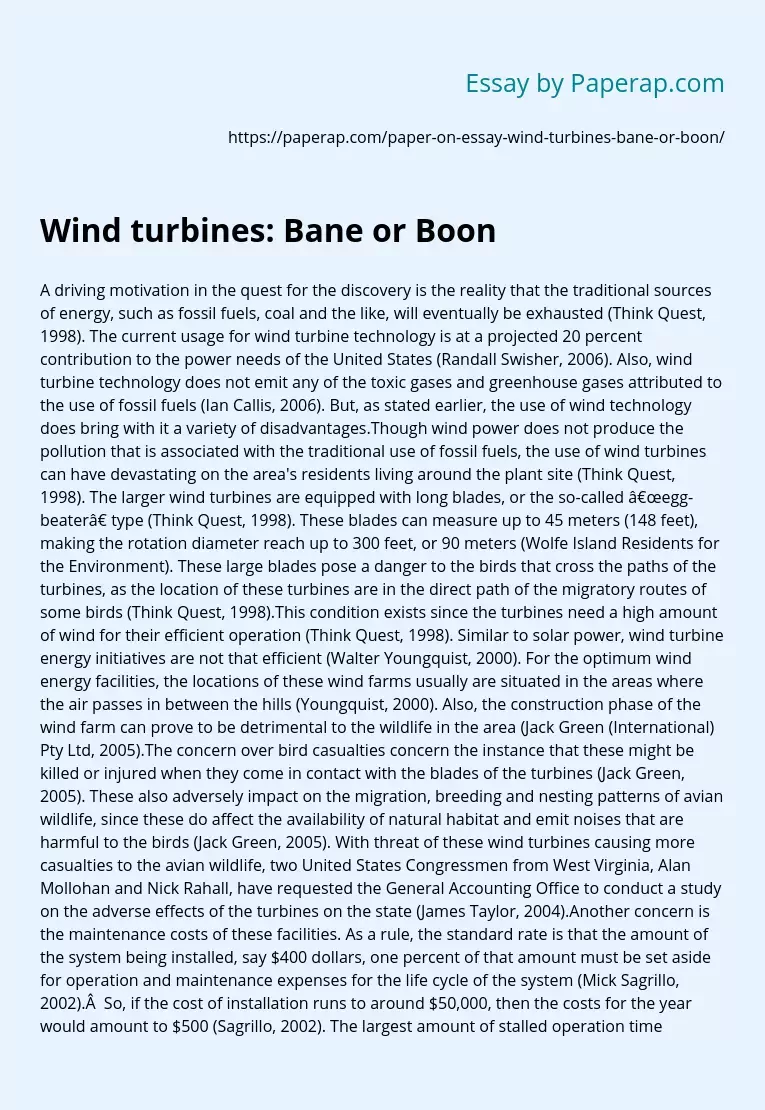Wind turbines: Bane or Boon
A driving motivation in the quest for the discovery is the reality that the traditional sources of energy, such as fossil fuels, coal and the like, will eventually be exhausted (Think Quest, 1998). The current usage for wind turbine technology is at a projected 20 percent contribution to the power needs of the United States (Randall Swisher, 2006). Also, wind turbine technology does not emit any of the toxic gases and greenhouse gases attributed to the use of fossil fuels (Ian Callis, 2006). But, as stated earlier, the use of wind technology does bring with it a variety of disadvantages.
Though wind power does not produce the pollution that is associated with the traditional use of fossil fuels, the use of wind turbines can have devastating on the area’s residents living around the plant site (Think Quest, 1998).
The larger wind turbines are equipped with long blades, or the so-called “egg-beater” type (Think Quest, 1998). These blades can measure up to 45 meters (148 feet), making the rotation diameter reach up to 300 feet, or 90 meters (Wolfe Island Residents for the Environment).
These large blades pose a danger to the birds that cross the paths of the turbines, as the location of these turbines are in the direct path of the migratory routes of some birds (Think Quest, 1998).This condition exists since the turbines need a high amount of wind for their efficient operation (Think Quest, 1998). Similar to solar power, wind turbine energy initiatives are not that efficient (Walter Youngquist, 2000). For the optimum wind energy facilities, the locations of these wind farms usually are situated in the areas where the air passes in between the hills (Youngquist, 2000).
Also, the construction phase of the wind farm can prove to be detrimental to the wildlife in the area (Jack Green (International) Pty Ltd, 2005).
The concern over bird casualties concern the instance that these might be killed or injured when they come in contact with the blades of the turbines (Jack Green, 2005). These also adversely impact on the migration, breeding and nesting patterns of avian wildlife, since these do affect the availability of natural habitat and emit noises that are harmful to the birds (Jack Green, 2005). With threat of these wind turbines causing more casualties to the avian wildlife, two United States Congressmen from West Virginia, Alan Mollohan and Nick Rahall, have requested the General Accounting Office to conduct a study on the adverse effects of the turbines on the state (James Taylor, 2004).Another concern is the maintenance costs of these facilities. As a rule, the standard rate is that the amount of the system being installed, say $400 dollars, one percent of that amount must be set aside for operation and maintenance expenses for the life cycle of the system (Mick Sagrillo, 2002). So, if the cost of installation runs to around $50,000, then the costs for the year would amount to $500 (Sagrillo, 2002).
The largest amount of stalled operation time for wind turbines has to do with gearbox damage (Gerald Munson). It is more evident when one small bearing fails in the turbine. If a bearing costing $ 1,500 breaks, this could result in major expenses, like the need for a gearbox replacement costing about $100,000, $50,000 to rewind the generator, and paying $70,000 for a crane to get to the turbine itself (Munson). All for one turbine and the cost escalates if the turbine is located off shore (Munson). Sadly, the fact is that about 6 out of 10 turbines in the United States are behind maintenance schedules (Renewable Energy Sources, 2008).The main factor to consider in the construction of a wind facility would be the unreliability of a steady supply of wind (Clean Energy Ideas, 2008). Under these conditions, solar or geothermal initiatives can be considered as an alternative (Clean, 2008). Also, some countries have imposed a tax on renewable energy, making their prices higher than countries that have invested in other more conventional alternative forms of energy generation (Nuclear Info, 2008). As such, the contribution effects of wind as a viable energy alternative is still considered to be minimal compared to that of oil (Youngquist, 2000).
Wind turbines: Bane or Boon. (2019, Jun 20). Retrieved from https://paperap.com/paper-on-essay-wind-turbines-bane-or-boon/

